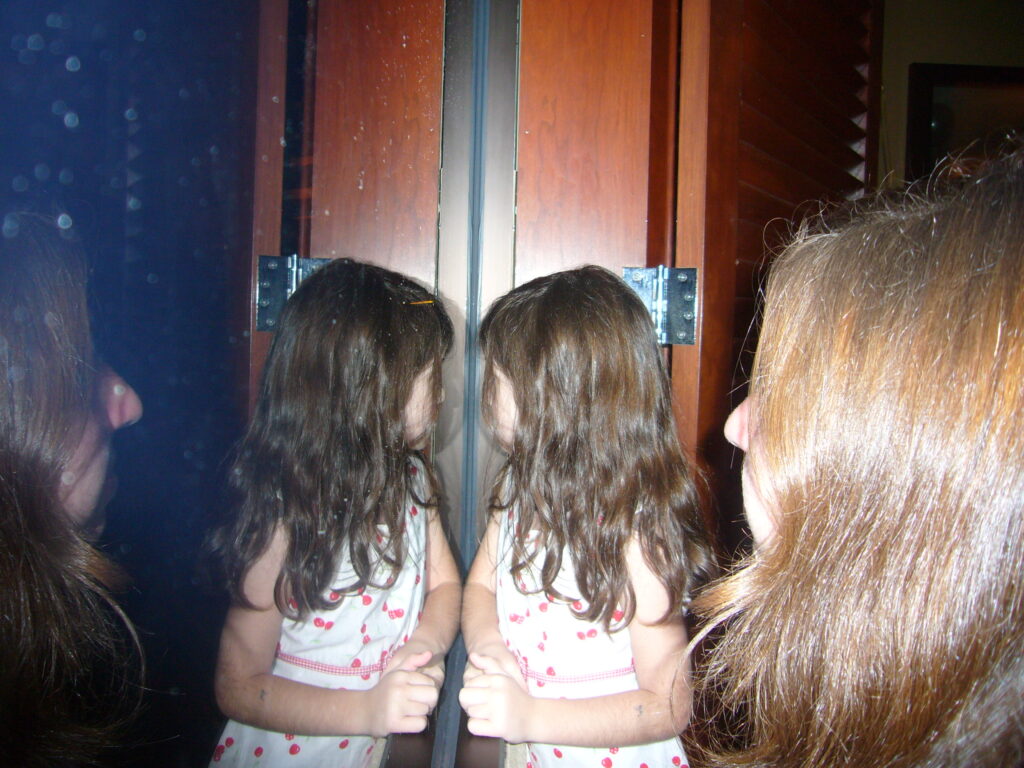I’ve spent my summer navigating my way through the written world of visual culture while also trying to think about my own interactions with imagery. From some of the earliest stages of life I’ve had the ability to look back at myself. For me, the famously known (Lacan’s) Mirror phase–although definitely still experienced through ground glass–was defined by my family’s desktop Dell computer screen as I looked through photos and videos of the life I was just starting to live. Favorite videos played and played again included Iris’ First Birthday, Iris at Christmas, Iris’ Bike Ride, Iris Eating Dinner, Iris Taking a Bath, Iris Sleeping … Iris simply existing. Long story short, I was handed a channel for self obsession at a young age. Growing up with constant personal digital archive access built the foundation for my quickly forming identity. As I got older, this image interaction was swayed by social pressures and funneled into social media access, arguably one of the most intensely saturated platforms for identity formation and self-preservation. I started the summer thinking about all of this…and wondering wider-scale how we all interact with images on the daily—and how this is affected by technology.
I think it’s important to look at how photography as an artistic medium interacts with memory. Our memories are ourselves, our identities, and pictures become the visual representation to our lives. Zooming out further, at the basis of visual culture is the idea that we see the material world through systems of representation–in this case images– and through those systems of representation we begin to piece together the world around us. This summer through my research I have sought to answer questions stirred up both by my personal experience with images, but also by thinking about my own intentions as a photographer. How is our daily interaction with images any different from photographic interactions? How is photography in practice different from this? How has technology influenced photography as an art form? Is it good or bad? Is art appropriation through technological mediums any different from before?
Modern memory relies entirely on the materiality of the trace, the immediacy of the recording, the visibility of the image. Our society heavily relies on the image, trusting it as an object of memory and truth holding. But I think that knowledge of our memory through documentation, and especially through digitally saturated documentation, comes at the cost of a distance from our actual memories. We are left to wonder if we remember going to the county fair in pictures posed with a perfectly swirled cone somewhere next to a ferris wheel, or if we remember going to the county fair in the feeling of sticky sweet cream on our tongue as we stand somewhere hot and loud and dusted in hay. This idea of images ‘stealing’ our memories is nothing new. But the noticeable distinction I am focusing on is that since the rise of easily accessible technologies used to document, take images and videos, the idea of images stealing our memories has accelerated into an overload of moments captured, selves presented, on a whole new level. If you asked me what I was doing on March 12th, 2021 I could probably tell you after taking a trip back into my camera roll. That day should be lost to me, but now I can see the 200 or so pictures of my friends and I posing against a pink and orange sky at a frigid looking beach.
With the creation of social media, our memories were able to appear digitally, and for an audience. As Jia Tolentino says in her book Trick Mirror, “on the internet, a highly functional person is one who can promise everything to an indefinitely increasing audience at all times” (Tolentino 16). In rebuke, Boris Groys’ book In the Flow states that “The internet betrays the search for the true self… the internet inscribes this search from its beginning back into nominal, socially codified identity” (Groys 8) As Groys goes on to describe, with the rise of universally accessible means of digital image production and distribution, “today there is nobody who is not involved in artistic activity of some kind” (Groys 9). This is true, and in my book this is a good thing in many many ways. With the internet, we have unprecedented access to creating and publishing images of or documenting artistic practices, as opposed to having platforms exclusively produced by those in power. As an artist, my digital media interactions feel confused, stuck between building my identity through images within my life, and building my identity as an artist using digital platforms to display my work. It all gets mixed together, confused. And I don’t think I’m the only one experiencing this– and furthermore, I think this relatively new phenomenon has created a strange hybrid mode of interacting with photography as an art. At this point in my research I have taken the time to build a foundation of knowledge so that I can begin to collect stories and opinions of others who interact with images and media similarly—or in complete opposition. I am really happy to have been able to take the time to build this foundation, which has also changed my own views as a lens-based artist and creative. My research–excitingly– has no end as technology continues to develop and our visual culture continues to change.
